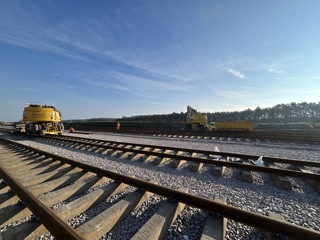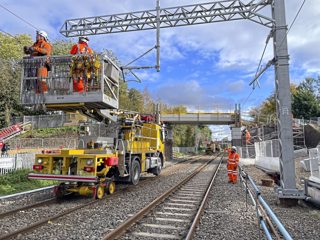Ian Tucker (pictured) is a Partner at Burges Salmon. A specialist rail lawyer who has acted for sector clients for over 15 years, his background is in UK and EU rail regulation and industry dispute resolution.
The Rail Reform Draft Bill was released shortly before the annual Rail Partners-sponsored George Bradshaw address.
At that debate, the Rail Minister and the Shadow Rail Minister agreed that reform was required, but set out competing visions for what it would look like - particularly in respect of private sector involvement in the operation of services.
Arguably, however, both government and opposition are proposing a change to the way the railways are run which will involve a centralised body taking joined-up decisions. Is the structure of the body envisaged by the Draft Bill therefore something they could actually agree on?
Huw Merriman (Rail Minister) seemed to be suggesting that it should be. He invited his opponent to agree to help him push through the Draft Bill, in order to get it on the books as soon as possible on the grounds (presumably) that it should not be contentious.
Stephen Morgan (shadow) seemed more reticent, presumably in part because his party had not yet published its detailed description of how it foresees the future industry structure (due in the next few weeks, he said). Also, he may not have had as long to scrutinise the drafting as the incumbent minister had.
Reflecting this, one questioner observed that while it was clear that a Conservative victory would result in rail reform in the structure envisaged in the Draft Bill, it wasn’t so clear what a Labour victory would mean.
If Labour chooses to abandon the Draft Bill and (potentially) to start again with White Papers, consultations and parliamentary drafting, the current statis could remain for a further extended period.
On that basis, Rail Partners Chief Executive Andy Bagnall repeated his opening remarks that the General Election in 2024 will be highly important to the railways and for, at least, the timings of reform.
Now that we have the text of the Draft Bill, it may be possible to consider what it does and does not provide for, and what scope there is for flexibility in the way it is applied.
The point is whether or not (to save time) the Draft Bill could actually accommodate Labour’s vision as well as the Conservative vision, such that both parties could get behind it and attempt to deliver it in this Parliament.
While that is ultimately a political rather than a legal question (and one I would accordingly hesitate to predict), it will depend to some degree on the precise provisions of the Draft Bill being proposed.
In turn, that will depend upon what the bill provides for in the key areas of difference between the parties - including, in particular, the role of the private sector.
Labour has not (at the time of writing) set out its detailed position on the future structure of the railways (in England).
However, given the numerous public statements from shadow ministers, I have assumed for the purposes of this article that under Labour’s reforms:
(a) the industry would be nationalised;
(b) current privately operated passenger franchises would be taken into public control as they expired;
(c) a publicly controlled body would act as guiding mind; and
(d) private owners of rolling stock and privately run freight businesses would continue to be welcomed to invest in the industry.
If so, the legal question is whether the current Draft Bill drafting would prevent any of those things.
A key point about the Draft Bill relates to its scope.
It is essentially quite a narrow proposal.
It creates a power for the Transport Secretary to nominate a corporate body to be an Integrated Rail Body (the ‘IRB’ soon to be on everyone’s lips), makes consequential amendments to allow that IRB to be both infrastructure manager and the body specifying railway services, and then lays down a number of controls and powers for the Department for Transport to influence that body.
Firstly, the fact that the IRB is to be a ‘body corporate’ is not an issue in principle.
That just means it is likely to be a ‘normal’ company registered at Companies House which in this case is likely to be owned/controlled by government (although actually a body corporate could also be separately created by statute - for example, Northern Ireland Transport Holding Co, which owns NIR).
While government would be free to consider other structures for a franchising body, the intention is to initially use Network Rail Infrastructure Limited (NRIL), which is a private company but a public body (until presumably NRIL is renamed Great British Railways or another corporate body with that name used to be the IRB).
So, would the IRB be sufficiently ‘public’ to count as having ‘nationalised’ the railways?
There is nothing in the Draft Bill to suggest that the IRB (ultimately GBR) would have to operate independently of government.
In fact (as below), probably the opposite in some cases.
So, would it (in practice) be too distant? Would it in fact be a reincarnation of the old Strategic Rail Authority (SRA), which was formed as an industry guiding mind and was arguably unwound when it sought to act too independently of the DfT.
The IRB envisaged is also not (despite superficial impressions) likely to be much like the SRA.
The SRA was a small organisation which did not itself attempt to get involved in the running of actual track, services, stations, depots, and so on. It could be seen as just a guiding mind.
The IRB/GBR is an infrastructure manager (the largest single entity in the railways already), as well as a specifier of services and a manager of operator contracts.
It will have its hands on the railway’s operating levers in a much more real sense, and be under scrutiny and dependent upon funding settlements accordingly.
There are provisions which clarify that the IRB will not be a crown body and its employees will not be crown employees, which some might see as putting this new rail body a little further away from pure ‘nationalisation’.
However, this is normal for public arm’s length bodies. And few would say it means that an organisation ultimately owned/controlled by government was not ‘nationalised’.
Also, under the Draft Bill, the Secretary of State will retain powers over the IRB which go beyond its shareholder and licensing powers.
In preparing the draft, the Government considered “that explicit powers of direction and guidance over the IRB provides more overt and transparent mechanisms for exercising control” than those of shareholder.
“The DfT considers it appropriate that the Secretary of State has more flexible, complementary mechanisms, in addition to the licence, to hold the IRB to account.”
These powers include DfT retaining the power to issue directions to IRB (which will be binding) and guidance (which will not), and the less direct obligation on IRB to “have regard to the Secretary of State’s statement of policy” on how the IRB should excise its powers when awarding franchises.
These powers are expressly wide enough to include directions from the DfT that IRB only acts after consultation with it or with its consent.
The Draft Bill therefore envisages a wide award of powers to the Secretary of State from time to time, which can be exercised by statutory instrument or simply ministerial guidance.
The content of such directions or guidance could presumably change according to who was in power.
A Labour Secretary of State could presumably issue directions and guidance that reflect its expectations, which are closer to its vision of a nationalised industry.
And a Conservative administration could use the powers in alternative ways in line with its policy.
In short, the Draft Bill itself would not be much of a constraining effect.
The question would be one of what (and how much) the incumbent administration chose to direct.
There is one section baked into the Draft Bill which does expressly invoke ongoing private sector participation in the railways.
That is a requirement on the IRB to have regard in the preparation of its business plan to the effect of its proposals on businesses in the private sector, and then to submit an annual report on how the actions it has taken will “increase the involvement of businesses in the private sector in the provision of railway services”.
Is the requirement to have regard and submit a report too far from nationalised public control of the railways for Labour policy?
It is also worth noting that the Draft Bill does not propose to remove the current obligation in the Railways Act requiring franchises not to be awarded to public bodies.
Would these decisions be too much for Labour to feel comfortable if the Draft Bill became legislation?
Will it target these provisions in the pre-legislative scrutiny to see if the current government will water them down as the price of progressing?
There are also structures built into the Draft Bill which do not go directly to the vision of reform of either party, but which are a reflection of this (current) administration’s decisions (for example, provisions around removal of performance regimes).
A new administration might simply not want to do it that way. In the same vein, a new administration might simply not want to be associated with its predecessor’s drafting.
Overall, it will be interesting to see how far the current Rail Minister gets with his invitation to his shadow to work together to get the Draft Bill through Parliament before the election. The general consensus seems to be that timings remain challenging.


















Login to comment
Comments
No comments have been made yet.